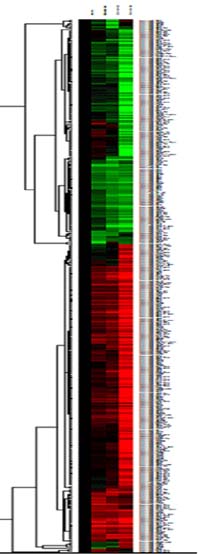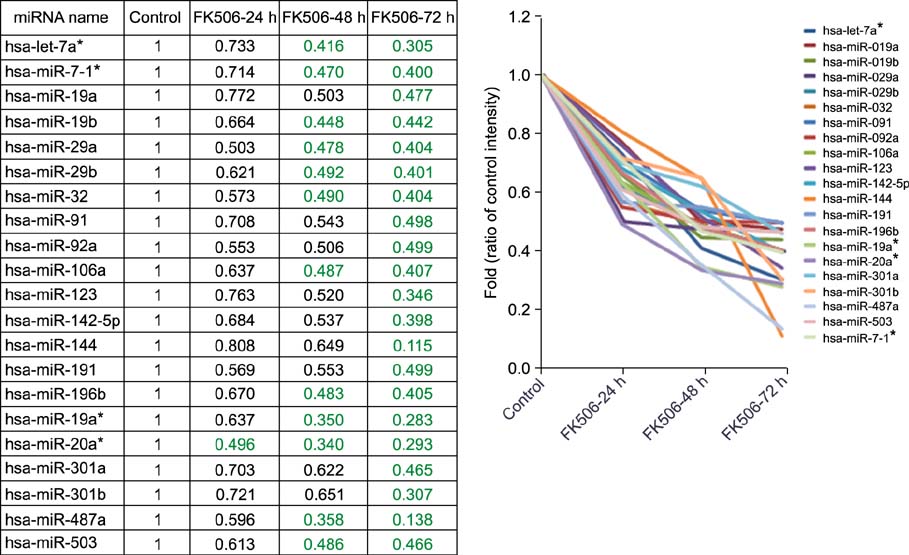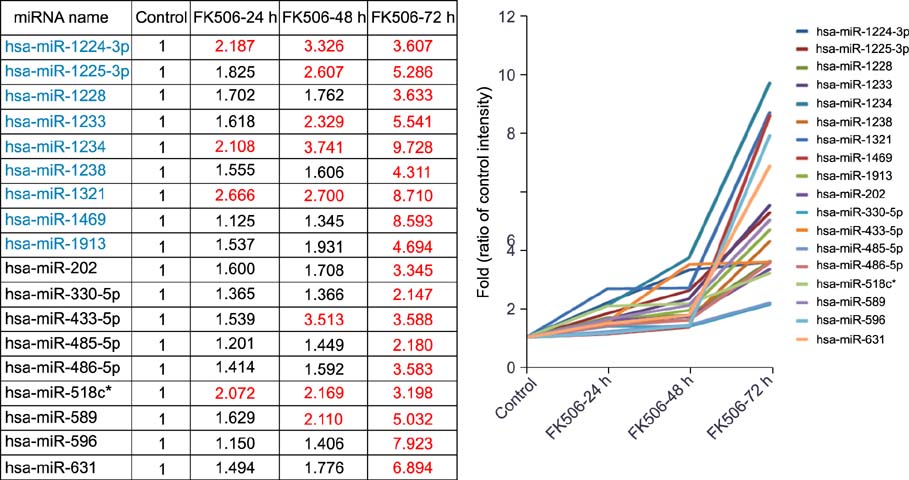J Korean Surg Soc.
2013 Oct;85(4):161-168. 10.4174/jkss.2013.85.4.161.
MicroRNA profiling of tacrolimus-stimulated Jurkat human T lympocytes
- Affiliations
-
- 1Department of Surgery, Chonnam National University Medical School, Gwangju, Korea. choisjn@chonnam.ac.kr
- KMID: 2096706
- DOI: http://doi.org/10.4174/jkss.2013.85.4.161
Abstract
- PURPOSE
This study investigated the Jurkat T cell line expresses cytotoxicity when treated with different concentrations of FK506, and analyzed the expression pattern of microRNA when stimulated by FK506 using the microRNAs microarray, as well as the expression pattern of a gene that is related to the differentiation, activation and proliferation of T cells after being affected by the change of microRNAs.
METHODS
To investigate the effects of FK506 on microRNA expression, we purified total RNA of Jurkat cells treated with 20 microM FK506 for 72 hours and used to analyze microRNA profiling by using Agilent's chip.
RESULTS
These results demonstrated that treatment with FK506 markedly induced the down-regulation of 20 microRNAs as well as the up-regulation of 20 microRNAs in a time-dependent manner. The genes that down-regulated by FK506 include let-7a*, miR-20a*, and miR-487a. Otherwise miR-202, miR-485-5p, and miR-518c* are gradually up-regulated in expression. Sanger Institute and DAVIDs bioinformatics indicated that microRNAs regulated the several transcriptomes including nuclear factor of activated T cell-related, T cell receptor/interleukin-2 signaling, and Ca(2+)-calmodulin-dependent phosphatase calcineurin pathways.
CONCLUSION
As a result of treating FK506 to a Jurkat cell line and running the microRNA microarray, it was found that FK506 not only took part in the suppression of T cell proliferation/activation by inhibiting calcineurin in Jurkat apoptosis, but also affected the microRNAs that are involved in the regulation of various signal transduction pathways.
Keyword
MeSH Terms
Figure
Reference
-
1. Arai S, Vogelsang GB. Management of graft-versus-host disease. Blood Rev. 2000; 14:190–204.2. Assmann T, Homey B, Ruzicka T. Applications of tacrolimus for the treatment of skin disorders. Immunopharmacology. 2000; 47:203–213.3. Hanauer SB, Dassopoulos T. Evolving treatment strategies for inflammatory bowel disease. Annu Rev Med. 2001; 52:299–318.4. Pridöhl O, Heinemann K, Hartwig T, Witzigmann H, Lamesch P, Fangmann J, et al. Low-dose immunosuppression with FK 506 and sirolimus after liver transplantation: 1-year results. Transplant Proc. 2001; 337:3229–3231.5. Ambros V. The functions of animal microRNAs. Nature. 2004; 431:350–355.6. Bartel DP. MicroRNAs: genomics, biogenesis, mechanism, and function. Cell. 2004; 116:281–297.7. Lim LP, Lau NC, Garrett-Engele P, Grimson A, Schelter JM, Castle J, et al. Microarray analysis shows that some microRNAs downregulate large numbers of target mRNAs. Nature. 2005; 433:769–773.8. Du T, Zamore PD. MicroPrimer: the biogenesis and function of microRNA. Development. 2005; 132:4645–4652.9. He L, Hannon GJ. MicroRNAs: small RNAs with a big role in gene regulation. Nat Rev Genet. 2004; 5:522–531.10. Bentwich I. Prediction and validation of microRNAs and their targets. FEBS Lett. 2005; 579:5904–5910.11. Berezikov E, van Tetering G, Verheul M, van de Belt J, van Laake L, Vos J, et al. Many novel mammalian microRNA candidates identified by extensive cloning and RAKE analysis. Genome Res. 2006; 16:1289–1298.12. Kaminska J, Nowacki MP, Kowalska M, Rysinska A, Chwalinski M, Fuksiewicz M, et al. Clinical significance of serum cytokine measurements in untreated colorectal cancer patients: soluble tumor necrosis factor receptor type I-an independent prognostic factor. Tumour Biol. 2005; 26:186–194.13. Luo C, Burgeon E, Carew JA, McCaffrey PG, Badalian TM, Lane WS, et al. Recombinant NFAT1 (NFATp) is regulated by calcineurin in T cells and mediates transcription of several cytokine genes. Mol Cell Biol. 1996; 16:3955–3966.14. Harding MW, Galat A, Uehling DE, Schreiber SL. A receptor for the immunosuppressant FK506 is a cis-trans peptidyl-prolyl isomerase. Nature. 1989; 341:758–760.15. Maki N, Sekiguchi F, Nishimaki J, Miwa K, Hayano T, Takahashi N, et al. Complementary DNA encoding the human T-cell FK506-binding protein, a peptidylprolyl cis-trans isomerase distinct from cyclophilin. Proc Natl Acad Sci U S A. 1990; 87:5440–5443.16. Standaert RF, Galat A, Verdine GL, Schreiber SL. Molecular cloning and overexpression of the human FK506-binding protein FKBP. Nature. 1990; 346:671–674.17. Brown EJ, Albers MW, Shin TB, Ichikawa K, Keith CT, Lane WS, et al. A mammalian protein targeted by G1-arresting rapamycin-receptor complex. Nature. 1994; 369:756–758.18. Akool el-S, Doller A, Babelova A, Tsalastra W, Moreth K, Schaefer L, et al. Molecular mechanisms of TGF beta receptor-triggered signaling cascades rapidly induced by the calcineurin inhibitors cyclosporin A and FK506. J Immunol. 2008; 181:2831–2845.19. Romano S, Mallardo M, Chiurazzi F, Bisogni R, D'Angelillo A, Liuzzi R, et al. The effect of FK506 on transforming growth factor beta signaling and apoptosis in chronic lymphocytic leukemia B cells. Haematologica. 2008; 93:1039–1048.20. Brown KD, Barlow C, Wynshaw-Boris A. Multiple ATM-dependent pathways: an explanation for pleiotropy. Am J Hum Genet. 1999; 64:46–50.21. Rolig RL, McKinnon PJ. Linking DNA damage and neurodegeneration. Trends Neurosci. 2000; 23:417–424.22. Barlow C, Liyanage M, Moens PB, Deng CX, Ried T, Wynshaw-Boris A. Partial rescue of the prophase I defects of Atm-deficient mice by p53 and p21 null alleles. Nat Genet. 1997; 17:462–466.23. Yan M, Kuang X, Qiang W, Shen J, Claypool K, Lynn WS, et al. Prevention of thymic lymphoma development in Atm-/- mice by dexamethasone. Cancer Res. 2002; 62:5153–5157.24. Benedini S, Ruffini E, Terruzzi I, Mancuso M, Luzi L. Glucose and leucine metabolism in lung tranplanted patients on low dose of steroids for immunosuppressive therapy. Transplant Proc. 2008; 40:1566–1571.25. Escribano O, Fernandez-Moreno MD, Pina MJ, Fueyo J, Menor C, Roman ID, et al. Pretreatment with FK506 up-regulates insulin receptors in regenerating rat liver. Hepatology. 2002; 36:555–561.26. Nattrass M, Lauritzen T. Review of prandial glucose regulation with repaglinide: a solution to the problem of hypoglycaemia in the treatment of Type 2 diabetes? Int J Obes Relat Metab Disord. 2000; 24 Suppl 3:S21–S31.27. Schwartz N, Schohl A, Ruthazer ES. Neural activity regulates synaptic properties and dendritic structure in vivo through calcineurin/NFAT signaling. Neuron. 2009; 62:655–669.28. Arie Y, Iketani M, Takamatsu K, Mikoshiba K, Goshima Y, Takei K. Developmental changes in the regulation of calcium-dependent neurite outgrowth. Biochem Biophys Res Commun. 2009; 379:11–15.29. Gómez AM, Rueda A, Sainte-Marie Y, Pereira L, Zissimopoulos S, Zhu X, et al. Mineralocorticoid modulation of cardiac ryanodine receptor activity is associated with downregulation of FK506-binding proteins. Circulation. 2009; 119:2179–2187.
- Full Text Links
- Actions
-
Cited
- CITED
-
- Close
- Share
- Similar articles
-
- Cytotoxic Mechanism of FK506 on Human T Lymphocytes
- Apoptosis Gene Expression Pattern Analysis of Jurkat Cells Treated with FK506
- Tacrolimus (FK506) Induced Apoptotic Signal Transduction Pathway
- The Effect of FK506 to Generate Reactive Oxygen Species on T Lymphocyte Death
- IL-12 and IL-23 Production in Toxoplasma gondii- or LPS-Treated Jurkat T Cells via PI3K and MAPK Signaling Pathways




